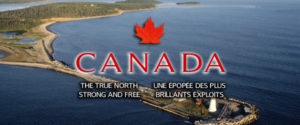
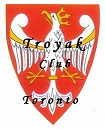
TROYAK EXECUTIVE TEAM is informing all members, colleagues, collectors, and Polonia at large, that Club meetings taking place at John Paul II Polish Cultural Centre, 4300 Cawthra Rd. (just south of Hwy. 403), Mississauga, Ontario. The new members are always welcome. www.polishculturalcentre.ca
ADRES SPOTKAÑ KLUBOWYCH ! Zarząd Główny Klubu “Troyak” informuje wszystkich członków kolekcjonerów, sympatyków oraz całą Polonię, że spotkania klubowe odbywają się w Polskim Centrum Kultury im. Jana Pawła II, przy 4300 Cawthra Rd. (na południe od autostrady 403), Mississauga, Ontario. Zapraszamy nowych członków do prężnego. Klubu “Troyak”. www.polishculturalcentre.ca

“TROYAK” CLUB NEXT MEETINGS …
NASTĘPNE SPOTKANIA KLUBU “TROYAK” …
July & August 2020 – Summer break … Letnie wakacje …
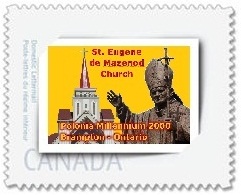
27th September 2020 @ 4:30 p.m.

4th October 2020 @ 9:00 a.m. to 4:00 p.m. …
Mississauga’s 5th Annual Fall Show

25th October 2020; 29th November 2020


Patroni Polski
Patrons of Poland
www.poczta-polska.pl
W dniu 16 maja 2020 został wprowadzony do obiegu znaczek pocztowy o wartości 3,30 zł emisji “Patroni Polski”. Na znaczku umieszczono zdjęcie fragmentu obrazu brata Bronisława Podsiadłego SJ przedstawiającą podobiznę Św. Andrzeja Boboli oraz roślinny motyw ozdobny z orłem w koronie. Znaczek wydrukowano techniką rotograwiurową, na papierze fluorescencyjnym, format znaczka: 43 x 31,25 mm, w nakładzie 150.000 szt. Arkusz sprzedażny zawiera 50 szt. znaczków. Z tej okazji została wydana również koperta FDC. Autor projektu: Bożydar Grozdew.
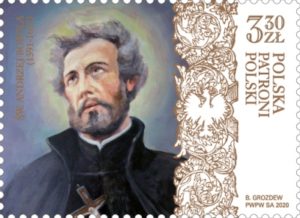
Patrons of Poland … denomination: 3,30 PLN;
number of stamps in set: 1; print run: 150.000 pcs.;
printing techniques: photogravure; paper: fluorescent;
stamp size: 43 x 31,25 mm; number of FDC: 1;
author: Bożydar Grozdew; circulation date: 16th May 2020.

Matka Boża z Koźla
Mother of God of Kędzierzyn-Koźle
www.poczta-polska.pl
Dnia 29 maja 2020 r. została wprowadzona do obiegu kartka pocztowa z nadrukowanym znakiem opłaty pocztowej, emisji: Matka Boża z Koźla. Wartość nominalna znaku opłaty pocztowej z oznaczeniem literowym A odpowiada wartości nominalnej znaczka pocztowego używanego do uiszczenia opłaty za ekonomiczną przesyłkę listową nierejestrowaną, w tym kartkę pocztową, w obrocie krajowym, w formacie S o masie do 500 g.
W prawym górnym rogu strony adresowej kartki nadrukowano znak opłaty pocztowej, na którym przedstawiono obraz z wizerunkiem Matki Bożej z Koźla, wzdłuż lewej krawędzi znaczka umieszczono napis: Polska oraz oznaczenie wartości: A. W części ilustracyjnej kartki znajduje się: nazwa emisji ,,Matka Boża z Koźla”, kolorowa fotografia pochodząca z Archiwum Urzędu Miasta przedstawiająca kościół św. Zygmunt i św. Jadwigi w Kędzierzynie-Koźlu. Kartki o wymiarach 148 x 105 mm wydrukowano jednostronnie, techniką offsetową, na kartonie białym, w nakładzie 8000 sztuk. Autor projektu kartki: Jan Konarzewski.
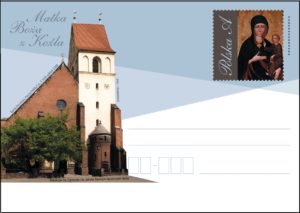
Mother of God of Kędzierzyn-Koźle … denomination: 3,30 PLN;
number of stationeries in set: 1; print run: 8.000 pcs;
printing technique: offset; card size: 148 x 105 mm;
author: Jan Konarzewski; release date: 29th May 2020.

100-lecie Muzeum Wojska Polskiego
100th Anniversary of the Polish Army Museum
www.poczta-polska.pl
Dnia 30 maja 2020 r. zostały wprowadzone do obiegu 3 kartki pocztowe z nadrukowanym znakiem opłaty pocztowej, emisji: 100-lecie Muzeum Wojska Polskiego. Wartość nominalna znaku opłaty pocztowej z oznaczeniem literowym A odpowiada wartości nominalnej znaczka pocztowego używanego do uiszczenia opłaty za ekonomiczną przesyłkę listową nierejestrowaną, w tym kartkę pocztową, w obrocie krajowym, w formacie S o masie do 500 g. Kartki o wymiarach 148 x 105 mm wydrukowano jednostronnie, techniką offsetową, na kartonie białym, w nakładzie 8000 sztuk. Autor projektu kartki: J. Ochendzan.
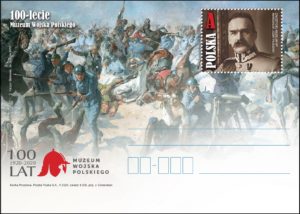
100th Anniversary of the Polish Army Museum …
denomination: 3,30 PLN; number of stationeries in set: 3;
print run: 8.000 pcs; printing technique: offset;
card size: 148 x 105 mm; author: J. Ochendzan;
release date: 30th May 2020.
Na kartkach pocztowych przedstawiono: na pierwszej – w części ilustracyjnej: pochodzący ze zbiorów Muzeum Wojska Polskiego obraz ,,Bitwa pod Zadwórzem” autorstwa S. Kaczora-Batowskiego; wzdłuż górnej krawędzi kartki umieszczono nazwę emisji: ,,100-lecie Muzeum Wojska Polskiego”, wzdłuż dolnej – logo obchodów 100-lecia Muzeum Wojska Polskiego. W prawym górnym rogu strony adresowej kartki nadrukowano znak opłaty pocztowej, na którym przedstawiono fotografię portretową Marszałka Józefa Piłsudskiego; wzdłuż lewej krawędzi znaczka umieszczono napis: POLSKA, w lewym górnym rogu – oznaczenie wartości: A, a wzdłuż prawej krawędzi – napis: ZAŁOŻYCIEL MUZEUM WP MARSZAŁEK JÓZEF PIŁSUDSKI.
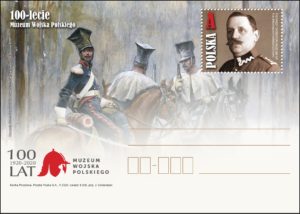
na drugiej – w części ilustracyjnej: pochodzącą ze zbiorów Muzeum Wojska Polskiego akwarelę ,,Patrol Szwoleżerów Gwardii” autorstwa B. Gembarzewskiego; wzdłuż górnej krawędzi umieszczono nazwę emisji: ,,100-lecie Muzeum Wojska Polskiego”, wzdłuż dolnej – logo obchodów 100-lecia Muzeum Wojska Polskiego. W prawym górnym rogu strony adresowej kartki nadrukowano znak opłaty pocztowej, na którym przedstawiono fotografię portretową płk. Bronisława Gembarzewskiego; wzdłuż lewej krawędzi znaczka umieszczono napis: POLSKA, w lewym górnym rogu – oznaczenie wartości: A, a wzdłuż prawej krawędzi – napis: PIERWSZY DYREKTOR MUZEUM WP PŁK BRONISŁAW GEMBARZEWSKI;
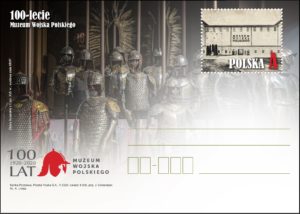
na trzeciej – w części ilustracyjnej: fotografię pochodzących ze stałej wystawy Muzeum Wojska Polskiego zbiorów husarskich z II poł. XVII w.; wzdłuż górnej krawędzi umieszczono nazwę emisji: ,,100-lecie Muzeum Wojska Polskiego”, wzdłuż dolnej – logo obchodów 100-lecia Muzeum Wojska Polskiego. W prawym górnym rogu strony adresowej kartki nadrukowano znak opłaty pocztowej, na którym przedstawiono widok budynku Muzeum Wojska Polskiego; wzdłuż dolnej krawędzi znaczka umieszczono napis: POLSKA i oznaczenie wartości: A.

100. Rocznica powstania Jagiellonii Białystok
100th Anniversary of the founding of Jagiellonia Białystok
www.poczta-polska.pl
W dniu 30 maja 2020 roku został wprowadzony do obiegu znaczek pocztowy o wartości 3,30 zł emisji “100. rocznica powstania Jagiellonii Białystok”.Znaczki wydrukowano techniką offsetową, na papierze fluorescencyjnym, w formacie 40,5 x 40,5 mm, w nakładzie 90 000 sztuk. Arkusz sprzedażny zawiera 5 sztuk znaczków i przywieszkę. Z tej okazji została wydana koperta FDC. Autor projektu: Jarosław Ochendzan.
Na znaczku przedstawiono historyczny herb Jagiellonii Białystok używany w latach 1987-1999, 2003-2006, który będzie używany od lipca 2020 roku oraz odznakę 42. Pułku Piechoty im. Generała Jana Henryka Dąbrowskiego z 1935 roku – protoplasty Jagiellonii Białystok. Na drugim planie widnieje fotografia drużyny piłkarskiej Jagiellonii Białystok z 1951 roku. Na przywieszce umieszczono powiększoną odznakę 42. Pułku Piechoty im. Generała Jana Henryka Dąbrowskiego z 1935 roku. Na kopercie umieszczono fotografię drużyny piłkarskiej Jagiellonii Białystok z 1932 roku. Kolorystyka projektu nawiązuje do barw klubowych. Data obiegu, 30 maja, to data pierwszego meczu z 1920 roku. Data emisji znaczka, upamiętniającego 100 lecie Klubu, wypada dokładnie 100 lat od daty pierwszego meczu.
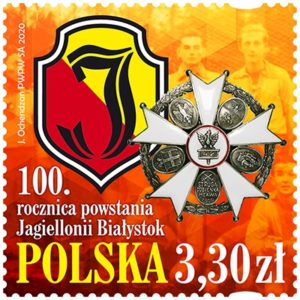
100th Anniversary of the founding of Jagiellonia Białystok …
denomination: 3,30 PLN; number of stamps in set: 1;
print run: 90.000 pcs; printing technique: offset;
stamp size: 40,5 x 40,5 mm; 5 stamps in sheet with label;
number of FDC: 1; author: Jarosław Ochendzan;
circulation date: 30th May 2020.
Jagiellonia Białystok to klub piłkarski występujący na najwyższym szczeblu rozgrywkowym w Polsce. Największe jego sukcesy to dwukrotne wicemistrzostwo kraju, Puchar Polski oraz Superpuchar Polski. Swój pierwszy mecz popularna Jaga rozegrała 30 maja 1920 roku, dlatego wydawnictwo Poczty Polskiej wchodzi do obiegu dokładnie 100 lat od tego wydarzenia.

Bezpieczny przejazd – „Szlaban na ryzyko!”
Safe passage – barrier to risk
www.poczta-polska.pl
W dniu 30 maja 2020 został wprowadzony do obiegu znaczek pocztowy o wartości 0,30 zł emisji “Bezpieczny przejazd – Szlaban na ryzyko!”. Na znaczku, po lewej stronie, przedstawiono słupek wskaźnikowy informujący o zbliżaniu się do przejazdu kolejowo – drogowego, a w środkowej części – czerwone tory kolejowe na czarnym tle. Wzdłuż górnej krawędzi znaczka umieszczono napis: BEZPIECZNY PRZEJAZD – ,,SZLABAN NA RYZYKO!”, a wzdłuż dolnej napis: POLSKA oraz oznaczenie wartości: 30 GR. Znaczek wydrukowano techniką rotograwiurową , na papierze fluorescencyjnym, w formacie znaczka 31,25 x 25,5 mm , w nakładzie 5 milionów sztuk. Arkusz sprzedażny zawiera 100 znaczków. Z tej okazji została wydana również koperta FDC. Autor projektu: Jan Konarzewski.
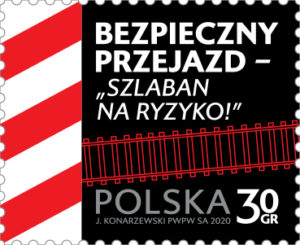
Safe passage – barrier to risk … denomination: 0,30 PLN;
number of stamps in set: 1; print run: 5 000 000;
printing techniques: photogravure; paper: fluorescent;
stamp size: 31,25 x 25,5 mm; 100 stamps in sheet;
number of FDC: 1; author: Jan Konarzewski;
circulation date: 30th May 2020.
Znaczek Bezpieczny Przejazd – Szlaban na ryzyko! można kupić we wszystkich placówkach pocztowych, tj. ponad 7,6 tys. lokalizacjach na terenie całego kraju. Oprócz znaczka Poczta Polska wydała, w limitowanej wersji, kopertę FDC, czyli kopertę wydawaną w pierwszym dniu obiegu znaczków. Widnieje na niej zdjęcie pociągu na przejeździe kolejowym oraz okolicznościowy datownik towarzyszący emisji filatelistycznej. Znaczek obiegowy Bezpieczny Przejazd – „Szlaban na ryzyko!”, wydany jest w 5 milionach sztuk. Na jego powierzchni o wymiarach 31,25 x 25,5 mm umieszony jest grafika torów oraz biało-czerwony znak, informujący kierowców o zbliżaniu się do przejazdu kolejowo-drogowego. Autor znaczka, Jan Konarzewski umieścił na nim także nazwę kampanii.
Kampania społeczna Bezpieczny przejazd – „Szlaban na ryzyko!”, to prowadzone od 15 lat cykliczne działania, mające ograniczać zdarzenia na przejazdach kolejowo-drogowych, przez zwiększanie świadomości uczestników ruchu drogowego. W ramach kampanii PLK prowadzą warsztaty dla instruktorów nauki jazdy oraz egzaminatorów WORD, akcje prewencyjne na przejazdach, prelekcje edukacyjne w szkołach i przedszkolach. Są działania w mediach oraz kolportaż materiałów informacyjnych. Ważną akcją było znakowanie wszystkich przejazdów kolejowo-drogowych żółtymi naklejkami z dodatkowymi informacjami, pozwalającymi na szybką reakcję, szczególnie wówczas, gdy na przejeździe zgaśnie samochód.

700-lecie konsekracji kościoła Mariackiego w Krakowie
www.nbp.pl
Narodowy Bank Polski jest centralnym bankiem państwa odpowiadającym za politykę pieniężną i stabilność cen. Jego funkcje określa Konstytucja Rzeczypospolitej Polskiej i ustawa o NBP. NBP ma wyłączne prawo emisji pieniądza. Jako bank centralny nie prowadzi rachunków bankowych obywateli, nie przyjmuje od nich lokat, nie udziela kredytów. Prowadzi natomiast obsługę budżetu państwa, a także podmiotów sektora finansów publicznych. Gromadzi rezerwy walutowe państwa i zarządza nimi. Pełni funkcję banku banków, tworząc warunki do działania systemu bankowego. Jest również jednym z najważniejszych ośrodków naukowo-analitycznych w dziedzinie ekonomii i rynków finansowych. 22 maja 2020 roku Narodowy Bank Polski wprowadził do obiegu srebrną monetę o nominale 50 zł „700-lecie konsekracji kościoła Mariackiego w Krakowie”.
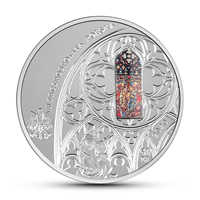
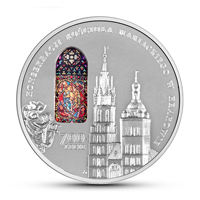
Nominał 50 zł … metal: Ag 999/1000; stempel: zwykły (szklana wstawka); średnica: 45,00 mm; masa: 62,20 g; brzeg (bok): gładki; nakład: do 6000 szt.; Projektant: Sebastian Mikołajczak; Emitent: NBP; Na zlecenie NBP monety wyprodukowała Mennica Polska S.A.
Awers monety przedstawia z prawej strony fragment okna z prezbiterium z kościoła Mariackiego w Krakowie z kolorowym witrażem przedstawiającym w górnej części maswerk późnogotycki z motywami roślinnymi oraz u dołu ukazującym postacie Józefa i Marii, ofiarowujących Dzieciątko Jezus w świątyni; pośrodku wizerunek postaci z predelli ołtarza Wita Stwosza wyobrażający drzewo Jessego. Rewers monety przedstawia z prawej strony wizerunek kościoła Mariackiego w Krakowie, z lewej strony kolorowy witraż.
W 2020 roku przypada 700-lecie konsekracji gotyckiego kościoła Mariackiego w Krakowie. Jego historia sięga lat dwudziestych XIII wieku. Według Jana Długosza pierwszy kościół parafialny został tu ufundowany w latach 1221–1222 przez biskupa krakowskiego Iwona Odrowąża, który ustanowił parafię, przenosząc ją z kościoła św. Trójcy oddanego przybyłym do Krakowa braciom dominikanom. W latach 1290–1300 wzniesiono, częściowo na jego fundamentach, nowy kościół w stylu wczesnogotyckim, poświęcony w 1320 roku przez biskupa Nankera. Przez kolejne stulecia budynek był wielokrotnie przebudowywany. W drugiej połowie XIV wieku powstało wydłużone jednonawowe prezbiterium przykryte sklepieniem gwiaździstym. W XVI wieku po obu stronach prezbiterium ustawiono nakryte baldachimami stalle, do których wiek później dodano płaskorzeźbione zaplecki ze scenami z życia Chrystusa i Maryi.
W latach 1477–1489 świątynia Mariacka wzbogaciła się o ołtarz wielki, arcydzieło rzeźbiarskie późnego gotyku dłuta mistrza Wita Stwosza. Poliptyk (pentaptyk) został poświęcony Matce Boskiej i Jej roli w dziele zbawienia Mesjasza, Jej Syna, Jezusa. W XVIII wieku, za czasów ks. inf. Jacka Łopackiego wnętrze świątyni poddano gruntownej modernizacji w stylu późnego baroku. W roku 1795 zlikwidowano przykościelny cmentarz. W jego miejsce powstał plac Mariacki. Część ocalałych epitafiów została przeniesiona na mury kościoła. U schyłku XIX wieku pod kierunkiem Tadeusza Stryjeńskiego przeprowadzono kolejną kompleksową restaurację świątyni. Jan Matejko zaprojektował wówczas dekorację malarską w prezbiterium, przy której wykonaniu pracowali m.in. Stanisław Wyspiański i Józef Mehoffer. Sklepienie imituje gwiaździste niebo, a ściany pokryte są malowidłami z motywami ornamentalnymi, heraldycznymi, tekstami modlitw maryjnych i postaciami aniołów grających na instrumentach lub trzymających banderole z tekstem litanii loretańskiej. Ostatnia gruntowna renowacja wnętrza świątyni została przeprowadzona na przełomie XX i XXI wieku. Obecnie trwają prace konserwatorskie przy ołtarzu Wita Stwosza i instrumentarium organowym. Informacja: Katarzyna Pakuła-Major.

700th Anniversary of the Consecration of
St. Mary’s Basilica in Kraków
www.nbp.pl
Narodowy Bank Polski is the central bank of the State, responsible for its monetary policy and price stability. The Bank’s functions are described in the Constitution of the Republic of Poland and the Act on NBP. NBP holds the exclusive right to issue the currency of the Republic of Poland. As the central bank, it does not provide accounts for the general public, accept deposits from or extend loans to individuals. It acts as a banker to the State budget and public sector entities. NBP also holds and manages the foreign exchange reserves of the State. Finally, it functions as a banker to banks, creating conditions for the operation of the Polish banking system. Narodowy Bank Polski is one of the most important research and analytical centres in the fields of economics and financial markets. On 22 May 2020, Narodowy Bank Polski issued into circulation a silver coin “700th Anniversary of the Consecration of St. Mary’s Basilica in Kraków”, with a face value of 50 złoty.


Face value: 50 zł … Metal: Ag 999/1000; Finish: standard (glass insert); Diameter: 45.00 mm; Weight: 62.20 g; Edge (side): plain; Mintage: up to 6,000 pcs.; Designer: Sebastian Mikołajczak; Issuer: NBP; The coins, commissioned by NBP, were struck by Mennica Polska S.A.
The obverse of the coin features – on the right – a fragment of a presbytery window from St. Mary’s Basilica in Kraków with colourful stained glass representing a late-Gothic tracery with floral patterns. At the bottom, it features the figures of Mary and Joseph presenting the infant Jesus at the temple. In the middle, there is an image of the figure from the predella of the Veit Stoss Altarpiece representing the Jesse Tree. The reverse of the coin features an image of St. Mary’s Basilica in Kraków on the right, and a colourful stained-glass window on the left.
The year 2020 marks the 700th Anniversary of the consecration of the Gothic St. Mary’s Basilica in Kraków. The history of the church goes back to the 1220s. According to chronicler Jan Długosz, the first parochial church was founded at the site in 1221–1222 by the Bishop of Kraków Iwo Odrowąż. He established the parish by transferring it from the Church of the Holy Trinity, allocated to the Dominican friars when they arrived in Kraków. In 1290–1300, anew church in early Gothic style was erected partly on its foundations and consecrated in 1320 by Bishop Nanker. Over the following centuries, the building underwent numerous alterations. An extended single-nave presbytery under a stellar vault was built in the second half of the 14th century. Stalls under canopies were added on both sides of the presbytery in the 16th century, and in the following century, they were equipped with backrests decorated with low reliefs featuring scenes from the lives of Jesus Christ and the Virgin Mary.
In 1477–1489, Saint Mary’s church was enriched with a grand altarpiece, a late Gothic sculptural masterpiece by Master Veit Stoss (Wit Stwosz). The polyptych (pentaptych) was consecrated to the Mother of God and her role in the work of salvation through the Messiah, Her Son Jesus. In the 18th century, in the time of Mitred Prelate Jacek Łopacki, the church interior was thoroughly modernised in the late Baroque style. In 1795, the church cemetery was deconstructed and St. Mary’s Square was built on its grounds. Some of the extant epitaphs were transferred onto the church walls. In the late 19th century, Tadeusz Stryjeński headed another extensive restoration of the temple. At that time, Jan Matejko designed painted decorations for the presbytery, which were created by Stanisław Wyspiański, Józef Mehoffer and other artists. The vault imitates a starry sky, and the walls are covered by paintings with ornamental and heraldic motifs, prayers to the Virgin Mary and figures of angels playing musical instruments or holding banderoles with the Litany of Loreto. The last thorough renovation of the church interior was carried out at the turn of the 21st century. The Veit Stoss Altarpiece and the organ are currently under restoration. Info: Katarzyna Pakuła-Major.

Odkryj Polskę – Kościół Mariacki
www.nbp.pl
Narodowy Bank Polski jest centralnym bankiem państwa odpowiadającym za politykę pieniężną i stabilność cen. Jego funkcje określa Konstytucja Rzeczypospolitej Polskiej i ustawa o NBP. NBP ma wyłączne prawo emisji pieniądza. Jako bank centralny nie prowadzi rachunków bankowych obywateli, nie przyjmuje od nich lokat, nie udziela kredytów. Prowadzi natomiast obsługę budżetu państwa, a także podmiotów sektora finansów publicznych. Gromadzi rezerwy walutowe państwa i zarządza nimi. Pełni funkcję banku banków, tworząc warunki do działania systemu bankowego. Jest również jednym z najważniejszych ośrodków naukowo-analitycznych w dziedzinie ekonomii i rynków finansowych. 22 maja 2020 roku Narodowy Bank Polski wprowadził do obiegu monetę z serii „Odkryj Polskę” – „Kościół Mariacki” o nominale 5 zł.
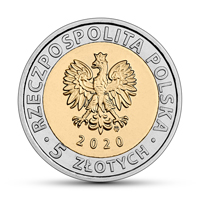
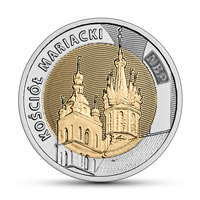
Nominał 5 zł … stop: pierścień MN25, rdzeń CuAl6Ni2; stempel: zwykły; średnica: 24,00 mm; masa: 6,54 g; brzeg (bok): moletowany nieregularnie; na boku ośmiokrotnie powtórzony napis: NBP, co drugi odwrócony o 180 stopni, rozdzielony gwiazdkami; nakład: do 1 200 000 szt.; Projektant: Dobrochna Surajewska; Emitent: NBP; Na zlecenie NBP monety wyprodukowała Mennica Polska S.A. Rewers monety przedstawia widok fasady kościoła Mariackiego w Krakowie od strony południowo-wschodniej.
Wokół Rynku Głównego, w sercu starego królewskiego miasta Krakowa, od 800 lat żyje i rozwija się parafia Mariacka. Jej symbolem i miejscem wyznawania wiary parafian, mieszkańców miasta i przyjezdnych gości jest kościół Mariacki – świątynia poświęcona Matce Bożej. Pierwsze wzmianki o istnieniu parafii pochodzą z lat dwudziestych XIII wieku. Źródła wskazują, że jej początki są związane ze sprowadzeniem do Krakowa przez biskupa Iwona Odrowąża zakonu dominikanów i przeniesieniem oddanej im wówczas parafii z kościoła św. Trójcy do świątyni Mariackiej. Tuż po wybudowaniu prezbiterium zaczęto odprawiać w niej nabożeństwa, jednak szybko rosnąca liczba wiernych skłoniła ówczesne władze kościelne i włodarzy miejskich do rozbudowy świątyni.
Wraz z rozwijającym się prężnie miastem predysponowała ona do roli miejskiej fary i tak pozostało do dziś. Cytując za Janem Długoszem: „[…] Setki fundacji, patronaty, bractwa, wspólnoty, cechy rzemiosł, rajcy, sędziowie, biskupi, mieszczanie kilku języków starali się hojnie ubogacić krakowską farę-matkę i źródło parafii krakowskich”. Tutaj też tradycja płynnie i harmonijnie łączy się z nowoczesnością. Święci, którzy czczeni są w tym miejscu od wieków, jak choćby św. Juda Tadeusz czy św. Antoni Padewski, spotykają się ze świętymi naszych czasów, m.in. ze św. Janem Pawłem II. Dlatego przy starszych nowennowych praktykach wiary pojawiają się także nowe inicjatywy. O duchowej witalności „Notre Dame de Cracovie” stanowią również prężnie działające mariackie wspólnoty. Nie jest to więc jedynie wspaniałej urody zabytek, nie tylko bryła z pięknymi i unikatowymi dziełami sztuki, które wyszły spod rąk najznakomitszych artystów. To miejsce szczególne dla wyznawców Chrystusa, które w sposób wyjątkowy towarzyszy wielu pokoleniom krakowian. Informacja: Katarzyna Pakuła-Major.

Discover Poland – St. Mary’s Basilica
www.nbp.pl http://mariacki.com/en/
Saint Mary’s Basilica (Polish: Kościół Mariacki) is a Brick Gothic church adjacent to the Main Market Square in Kraków, Poland. Built-in the 14th century, its foundations date back to the early 13th century and serve as one of the best examples of Polish Gothic architecture. Standing 80 m (262 ft) tall, it is particularly famous for its wooden altarpiece carved by Veit Stoss (Wit Stwosz). In 1978 it became a UNESCO World Heritage Site alongside the Historic Centre of Kraków. On every hour, a trumpet signal—called the Hejnał mariacki—is played from the top of the taller of Saint Mary’s two towers. The plaintive tune breaks off in mid-stream, to commemorate a famous 13th-century trumpeter who was shot in the throat while sounding the alarm before a Mongol attack on the city. The noon-time hejnał is heard across Poland and abroad broadcast live by the Polish national Radio 1 Station.
Saint Mary’s Basilica also served as an architectural model for many of the churches that were built by the Polish diaspora abroad, particularly those like Saint Michael’s and Saint John Cantius in Chicago, designed in the Polish Cathedral style. According to chronicler Jan Długosz, Saint Mary’s Basilica in the Main Square in Kraków was founded in 1221–22 by the Bishop of Kraków, Iwo Odrowąż. The building was destroyed during the Mongol invasion of Poland. Between 1290–1300 the new early Gothic church was built on the remaining foundations. It was consecrated twenty years later, in 1320.


Face value: 5 zł … Alloy: ring: MN25 core: CuAl6Ni2; Finish: standard; Diameter: 24.00 mm; Weight: 6.54 g; Edge (side): …; Mintage: up to 1200,000 pcs.; Designer: Dobrochna Surajewska; Issuer: NBP; The coins, commissioned by NBP, were struck by Mennica Polska S.A. Date of issue: 22-05-2020.
The church was completely rebuilt during the reign of Casimir III the Great between 1355 and 1365 with substantial contributions from wealthy restaurateur Mikołaj Wierzynek. The presbytery was elongated and tall windows added. The main body of the church was completed in 1395–97 with the new vault constructed by master Nicholas Wernher from Prague. However, the vault over the presbytery collapsed in 1442 due to a possible earthquake, which has never happened before nor since in Kraków. In the first half of the 15th century, the side chapels were added. Most of them were the work of Master Franciszek Wiechoń. At the same time, the northern tower was raised and designed to serve as the watchtower for the entire city. In 1478 carpenter Maciej Heringh (or Heringk) funded a helmet for the tower. A gilded crown was placed on it in 1666, which is still present today. At the end of the 15th century, Saint Mary’s church was enriched with a sculptural masterpiece, an Altarpiece of Veit Stoss (Ołtarz Mariacki Wita Stwosza) of late Gothic design.
In 1536/37, King Sigismund I. declared that the sermons in the church should be changed from German to Polish. The large German community of Kraków were relocating their place of worship to the smaller Saint Barbara’s church. In the 18th century, by the decision of vicar Jacek Augustyn Łopacki, the interior was rebuilt in the late Baroque style. The author of this work was Francesco Placidi. All 26 altars, equipment, furniture, benches and paintings were replaced and the walls were decorated with polychrome, the work of Andrzej Radwański.
At the beginning of the 19th century, the city decided that a cemetery near the Basilica was to be shut down and replaced by a public square. Today, it is known as Plac Mariacki (Marian Square). In the years 1887–1891, under the direction of Tadeusz Stryjeński, the neo-Gothic design was introduced into the Basilica. The temple gained a new design and murals painted and funded by Jan Matejko, who worked with Stanislaw Wyspianski and Józef Mehoffer – the authors of stained glass in the presbytery. Since the beginning of 1990s, the Basilica underwent an extensive renovation. In 2003, in the final stage of the works, the roof of the church was replaced. On 18 April 2010, in Saint Mary’s Basilica, a funeral ceremony for Polish President Lech Kaczyński and his wife Maria was held. The coffins were later transported and buried in one of the crypts of Wawel Cathedral.


History of Radio: PermanentTM Domestic stamps
www.canadapost.ca
Celebrate the 100th anniversary of Canada’s first radio broadcast, a pivotal moment for Canadians, with this booklet of 10 PermanentTM domestic stamps. Issued on May 20, 2020, this booklet takes a peek into Canada’s broadcasting past. The advent of radio fundamentally changed the way Canadians consumed news, music and entertainment. May 20, 2020, marks the 100th anniversary of the first radio broadcast in Canada. Transmitted by XWA in Montréal to a Royal Society of Canada gathering at Ottawa’s Chateau Laurier, the broadcast featured a live performance by soprano Dorothy Lutton. Radio was embraced quickly and wholeheartedly by Canadians. By the end of the decade, tens of thousands of Canadians were tuning in.
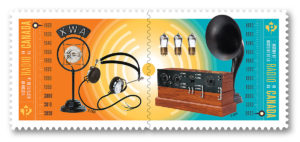
Stamp Value: PermanentTM (domestic rate) …
Issue Date: May 20, 2020; Quantity Produced: 130,000;
Dimensions: 34 mm x 29 mm; Stamp Designer: Soapbox Design.
History of Radio: Official First Day Cover … Celebrate the 100th anniversary of Canada’s first radio broadcast, a pivotal moment for Canadians, with this Official First Day Cover. Issued on May 20, 2020, and cancelled in Montréal, QC, this Official First Day Cover takes a peek into Canada’s broadcasting past. From that point forward, radio spread quickly. Canadians loved how it ushered the world into their homes. By the end of the decade, the number of radio sets across the country had grown from fewer than 10,000 to nearly 300,000. Quantity Produced: 7,000; Dimensions: 190 mm x 112 mm. Cancellation site: Montréal, QC.

From Far and Wide 2020: Postage-paid postcards
www.canadapost.ca
Some of Canada’s most iconic landscapes are captured in this set of nine postage-paid postcards from our From Far and Wide stamp series. Enjoy as part of your collection or send anywhere in the world. Each postcard features a photograph capturing a quintessentially Canadian location: Kootenay National Park, BC; Swallowtail Lighthouse, Grand Manan Island, NB; Cabot Trail, Cape Breton Island, NS. Stamp Designer: Stéphane Huot. Issue Date: January 13, 2020. (Set of 9) … #3

From Far and Wide 2020: Postage-paid postcard – Kootenay National Park (BC) … Send a bit of the rugged beauty of the Canadian Rockies with this postage-paid postcard featuring British Columbia’s spectacular Kootenay National Park. This postcard can be mailed from Canada to anywhere in the world. Part of the third From Far and Wide stamp issue honouring must-see Canadian destinations, this postcard features an enlarged image from one of the nine landscapes in this year’s issue. Celebrating its 100th anniversary in 2020, Kootenay National Park is one of seven national and provincial parks that make up the Canadian Rocky Mountain Parks World Heritage Site. Spanning more than 1,400 km2, Kootenay is home to the Radium Hot Springs and draws hundreds of thousands of visitors every year.

From Far and Wide 2020: Postage-paid postcard – Swallowtail Lighthouse, Grand Manan Island (NB) … Take in the magnificent vistas from New Brunswick with this postage-paid postcard featuring Grand Manan Island’s historic Swallowtail Lighthouse. This postcard can be mailed from Canada to anywhere in the world. Part of the third From Far and Wide stamp issue honouring must-see Canadian destinations, this postcard features an enlarged image from one of the nine landscapes in this year’s issue. The first lighthouse to be built on Grand Manan Island in the Bay of Fundy, Swallowtail Lighthouse started service in 1860, its construction spurred by the shipwreck of the Lord Ashburton and the loss of 21 crew members. Swallowtail is perched on a high rugged peninsula that offers magnificent views and opportunities for seal, whale and seabird watching.

From Far and Wide 2020: Postage-paid postcard – Cabot Trail, Cape Breton Island (NS) … Marvel at the stunning coastal views of Cape Breton Island’s Cabot Trail with this postage-paid postcard. This postcard can be mailed from Canada to anywhere in the world. Part of the third From Far and Wide stamp issue honouring must-see Canadian destinations, this postcard features an enlarged image from one of the nine landscapes in this year’s issue. The Cabot Trail is an award-winning year-round road that provides visitors with easy access to activities ranging from hiking, cycling and golfing to swimming, whale watching and sea kayaking. Almost 300 km in length, the route loops around the northern part of the island, offering stunning coastal views and rugged highland panoramas.

2020 … $3 Pure Silver Coloured Coin –
Purple Violet: Floral Emblems of Canada:
New Brunswick
www.mint.ca www.canadapost.ca www.gov.nb.ca
The purple violet is a water-loving perennial herb–if it’s not growing in water, it’s likely growing near it. Its blue-centred blooms will catch your eye from May to July, when they add a punch of colour to meadows, bogs and open woodlands. New Brunswick’s official flower is one of several Canadian emblems that were selected by means of public input. It’s also the featured star of our 4th Floral Emblems of Canada coin series, with a reverse design that captures the look of antique silver jewellery.
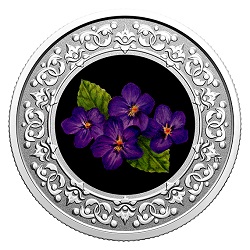
Face value: 3 dollars … Composition: 99.99% Pure Silver;
Mintage: 4,000; Weight: 7.96 g; Diameter: 27 mm;
Finish: Reverse Proof; Edge: serrated; Certificate: serialized;
Artist: Lisa Thomson-Khan (reverse); Susanna Blunt (obverse).
Design: The reverse design by Canadian artist Lisa Thomson-Khan features a stylized floral pattern on the outer ring, while the inner core features a colour portrait of the official floral emblem of New Brunswick, the purple violet (Viola cucullata). The obverse features the effigy of Her Majesty Queen Elizabeth II by Susanna Blunt.
Did you know… *** This wildflower of eastern Canada occurs from Ontario eastward to Newfoundland and Labrador. Its species name, cucullata, means “hoodlike.” It’s considered a stemless violet, meaning its flowers and leaves rise up from the rhizome buried in the ground. *** The purple violet became New Brunswick’s official flower on December 1, 1936. It was selected after consultation with the Women’s Institute, the province’s schoolchildren and the Lieutenant Governor. *** Think you have a purple violet in your garden or outdoor space? Violets can be tricky to identify (there are a few different species) but look very closely at the lower side petals–the purple violet is the only one with swollen/club-tipped beard hairs.

2020 … $3 Pure Silver Coloured Coin –
Prairie Crocus: Floral Emblems of Canada:
Manitoba
www.mint.ca www.canadapost.ca www.manitoba.ca
Gosling plant, pasqueflower, windflower and more—Manitoba’s floral emblem, the prairie crocus, is a very early flowering beauty that goes by many names. Fluffy and fuzzy, this purple-coloured sign of spring became the official flower in 1906, when it was suggested by the Manitoba Horticultural Society and put to a vote among the province’s schoolchildren. One of several provincial emblems selected by popular vote, the enchanting prairie crocus is in bloom on our fifth Floral Emblems of Canada coin that captures the look of antique silver jewellery.
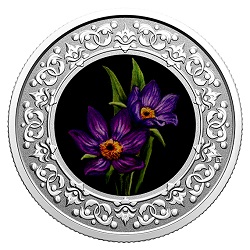
Face value: 3 dollars … Composition: 99.99% Pure Silver;
Mintage: 4,000; Weight: 7.96 g; Diameter: 27 mm;
Finish: Reverse Proof; Edge: serrated; Certificate: serialized;
Artist: Lisa Thomson-Khan (reverse); Susanna Blunt (obverse).
Design: The reverse design by Canadian artist Lisa Thomson-Khan features a colour portrait of the official floral emblem of Manitoba, the prairie crocus (Pulsatilla ludoviciana). The obverse features the effigy of Her Majesty Queen Elizabeth II by Susanna Blunt.
Did you know… *** This diminutive flower can be found from the Hudson Bay area of Quebec and Ontario, Manitoba west to British Columbia, and north into Yukon and Northwest Territories. *** Its mauve petals can appear before the last of the winter snow has melted. Why does it bloom so early? It gives the prairie crocus a competitive advantage: any available pollinators will be drawn to it first, and if the conditions are right, its seeds will be ripe by June. By July, its growth has peaked and it will die back to prepare for winter, thereby avoiding the sweltering summer heat. *** Despite its name, the prairie crocus isn’t really a crocus — it’s an anemone. *** Be patient if you try to grow it from seed in your garden: it can take 3-4 years for the first flowers to appear. *** The prairie crocus won the hearts of Manitoba’s schoolchildren in 1906. The other choices were the prairie lily (it came in second) and the wild rose (it came in third).

2020 … $3 Pure Silver Coloured Coin –
Pacific Dogwood: Floral Emblems of Canada:
British Columbia
www.mint.ca www.canadapost.ca www.gov.bc.ca
British Columbia’s floral emblem isn’t so much a flower, but a flowering tree– a unique trait that sets the Pacific dogwood apart from our other provincial and territorial blooms. The showy white flowers on our sixth Floral Emblems of Canada coin appear each spring, and occasionally in September too. The tree itself, Cornus nuttallii, is a four-season beauty that can grow as high as 18 metres. And while the flowering dogwood was a popular image in British Columbia prior to 1956, the Floral Emblem Act assured its position as the official symbol of Canada’s westernmost province. The flowering Pacific dogwood is the star of our sixth jewellery-inspired Floral Emblems of Canada coin. Collect all 13 coins for a complete set!
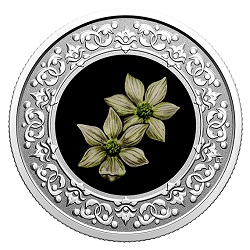
Face value: 3 dollars … Composition: 99.99% Pure Silver;
Mintage: 4,000; Weight: 7.96 g; Diameter: 27 mm;
Finish: Reverse Proof; Edge: serrated; Certificate: serialized;
Artist: Lisa Thomson-Khan (reverse); Susanna Blunt (obverse).
Design: The reverse design by Canadian artist Lisa Thomson-Khan features a colour portrait of the official floral emblem of British Columbia, the Pacific dogwood (Cornus nuttallii), surrounded by a stylized floral pattern. The obverse features the effigy of Her Majesty Queen Elizabeth II by Susanna Blunt.
Did you know… *** Depending on your location, you might want to think twice before you pluck these blooms – it’s illegal to pick Pacific dogwood flowers in British Columbia. *** Take a closer look: the true flower is the cluster of small green petals at the centre of the white bracts (specialized leaves) that get all the attention! *** Discussions about B.C.’s floral emblem began in the 1930s. The Pacific dogwood was repeatedly championed and got a popularity boost during the Second World War when lapel pins modelled after its flowers were sold to raise funds for soldiers fighting overseas. Other species, including the wild columbine, were also recommended by various committees and organizations. Despite arguments that it had a limited presence in the province, the Pacific dogwood was formally adopted as an official symbol of British Columbia in 1956. *** British Columbia’s floral emblem is well represented on the province’s coat of arms: in 1987, a collar of dogwood flowers was added to the Royal Crest and a garland was entwined around the motto.

2020 … $3 Pure Silver Coloured Coin –
Lady’s Slipper: Floral Emblems of Canada:
Prince Edward Island
www.mint.ca www.canadapost.ca www.gov.pe.ca
Canada’s island province is home to three indigenous species of lady’s slippers, but it is the pink lady’s slipper (Cypripedium acaule) that has the honour of being on our seventh Floral Emblems of Canada coin. The reverse features a captivating portrait of the slow-growing woodland beauty, which is elegantly framed by an antique jewellery-inspired design.
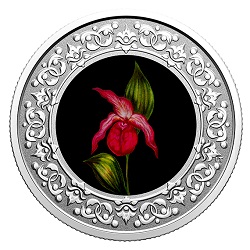
Face value: 3 dollars … Composition: 99.99% Pure Silver;
Mintage: 4,000; Weight: 7.96 g; Diameter: 27 mm;
Finish: Reverse Proof; Edge: serrated; Certificate: serialized;
Artist: Lisa Thomson-Khan (reverse); Susanna Blunt (obverse).
Design: The reverse design by Canadian artist Lisa Thomson-Khan features a colour portrait of the official floral emblem of Prince Edward Island, the pink lady’s slipper (Cypripedium acaule). The obverse features the effigy of Her Majesty Queen Elizabeth II by Susanna Blunt.
Did you know… *** The generic lady’s slipper was designated the provincial flower of Prince Edward Island on April 25, 1947. At first, it was represented by the showy lady’s slipper, which is uncommon in the province. In 1965, the pink lady’s slipper (Cypripedium acaule) or moccasin flower was recognized as the official emblem. *** This flower gets its name from the pouch-like petals that form the shape of a slipper. Contrary to its name, the pink lady’s slipper isn’t necessarily pink: its petals can also be white, though this is less common. *** Canada is home to eight different species of lady’s slippers, including the pink lady’s slipper that can be found across much of Canada—except in British Columbia, Yukon and Nunavut.

2020 … $100 Pure Silver Coin
– Liberation of the Netherlands:
Operation Manna
www.mint.ca www.canadapost.ca
Celebrate the close friendship that exists between Canada and the Netherlands with this 10 ounce, a pure silver coin that serves as a portrait of solidarity and courage against a backdrop of war. Its design highlights Canada’s involvement in the food drops that cemented the bond forged between our two countries 75 years ago. As part of our 2020 V-E Day collection, this premium piece bears a Victory privy mark and comes packaged in a special V-E Day beauty box. Its selectively gold-plated design highlights Canada’s involvement in the Allied food drops of 1945, which provided much-needed relief to millions of starving civilians still trapped behind enemy lines. And with a diameter of 76.25 mm, this is our largest Liberation of the Netherlands-themed tribute to the Canadians who fought for freedom on the ground and at sea, and to those who delivered hope from above.
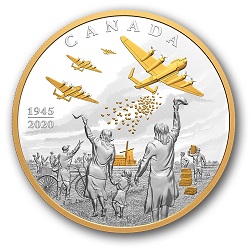
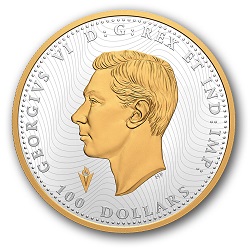
Face value: 100 dollars … Composition: 99.99% Pure Silver
with gold plating; Mintage: 550; Weight: 311.53 g;
Diameter: 76.25 mm; Finish:Proof; Edge: Serrated;
Certificate: serialized; Artist: John Mantha (reverse).
As part of our 2020 V-E Day collection, this premium piece bears a Victory privy mark and comes packaged in a special V-E Day beauty box. Its selectively gold-plated design highlights Canada’s involvement in the Allied food drops of 1945, which provided much-needed relief to millions of starving civilians still trapped behind enemy lines. And with a diameter of 76.25 mm, this is our largest Liberation of the Netherlands-themed tribute to the Canadians who fought for freedom on the ground and at sea, and to those who delivered hope from above.
“Operation Manna is a significant milestone in the Second World War and the shared history of the Netherlands and Canada. The operation, which involved air-dropping food and fuel supplies, saved thousands of Dutch citizens. We are proud that this coin highlights the crucial Canadian involvement in the Allied food drops in 1945. It is a fitting tribute to the Canadians who fought for our freedom. We will never forget!” His Excellency Henk van der Zwan, Ambassador of the Kingdom of the Netherlands to Canada.
Design: Double-dated to commemorate the 75th anniversary of the Liberation of the Netherlands (“1945” “2020”), the reverse design by Canadian artist John Mantha features a ground-level view of Operation Manna (April 29-May 8, 1945) from the perspective of Dutch civilians. Flying low over a designated drop zone in the western Netherlands, one of the Lancaster bombers flown by Canadian aircrews of RAF Bomber Command has dropped her cargo. Selective gold plating highlights the bombers, the packages and the windmill on the reverse, as well as the rim on both sides. The selectively gold-plated obverse features the effigy of King George VI by T.H. Paget and a “V for Victory” privy mark.
Did you know… *** Five Canadians (Flight Sergeant Robert Fairful Upcott, DFM, pilot, Sergeant William Arthur Walton, navigator; Sergeant William Gray, bomb aimer, Sergeant Charles Henry Orval Blower, mid-upper gunner and Sergeant William James Demo, rear gunner) were onboard the RAF Avro Lancaster that performed the first food drop. Named “Bad Penny,” the bomber took off in cloudy weather on April 29 with full cargo and successfully made the drop over the Duindigt racetrack near The Hague. *** What were in those packages? Food supplies included flour, sugar, margarine, salt, tinned meat and biscuits, dried milk and whole egg powder, coffee and tea, cheese, chocolate and potatoes.

2020 … $50 Pure Silver Coin –
Franklin’s Lost Arctic Expedition
www.mint.ca www.canadapost.ca
This large (68 mm) pure silver coin honours the memory of Sir John Franklin’s ill-fated expedition across the Arctic. It also celebrates the achievements of those who discovered Franklin’s lost ships in Canada’s northern waters. The scene on the coin shows one of Franklin’s ships, the HMS Terror, trapped in the ice. Corrugated edges give the coin a jagged ice-like outline. On the reverse, an aurora borealis appears as survivors abandon the ship to their doom. The coin captures the bravery and sacrifices that are part of the history of Arctic exploration that mapped the Canadian Arctic. The Parks Canada-led discovery of the wrecks is also a historic event, which was made possible thanks to Inuit oral tradition and modern science.
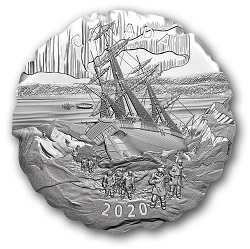
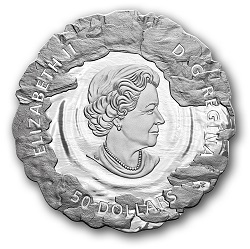
Face value: 50 dollars … Composition: 99.99% Pure Silver;
Mintage: 750; Weight: 157.6 g; Diameter: 68.81 mm;
Finish:Proof; Edge: Corrugated-edged;
Artist: Matt Bowen (reverse).
It was the Arctic voyage that launched a 170-year search. Sir John Franklin’s lost expedition is one of history’s greatest mysteries and, until recently, it seemed fated to remain unsolved. But by combining technology with Inuit traditional knowledge (Inuit Qaujimajatuqangit), archaeologists recently discovered two key pieces of the story that may yield more answers: Franklin’s lost ships, including the one shown on this coin.
Design: Designed by Royal Canadian Mint engraver Matt Bowen, the reverse features an artist’s rendition of the doomed Franklin expedition (1845-1848). The coin’s corrugated edge resembles jagged ice, which has HMS Terror firmly in its grasp on the reverse. In a desperate attempt to survive, the surviving crew and officers are seen abandoning the ship, with one group in the distance hauling a lifeboat towards King William Island. The obverse features the effigy of Her Majesty Queen Elizabeth II by Susanna Blunt.
Did you know… *** Since 1848, more than 90 different search expeditions have attempted to find Franklin’s expedition or evidence of its fate. The only written record is a single sheet of Admiralty paper found in a stone cairn in 1859. Handwritten notes indicated the ships had been locked in ice for 19 months before being abandoned on April 22, 1848, when survivors moved onto King William Island and tried to reach the mainland. *** In 2008, Parks Canada’s Underwater Archaeology Team (UAT) and partners embarked on a new annual search for the lost ships using underwater technology and Inuit testimony. On September 1, 2014, a helicopter team uncovered two objects that shifted the focus to the shallow waters of Wilmot and Crampton Bay, where HMS Erebus was discovered the next day. *** In 2016, HMS Terror was discovered nearly 100 kilometres south of the point where she was thought to have been crushed by ice. A resident of Gjoa Haven reported seeing a tall piece of wood rising up through the ice. Based on this account, a research vessel detoured to Terror Bay, where HMS Terror was discovered resting on the seafloor.


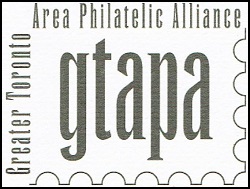
www.gtapa.org
The GTAPA is committed to promoting and
stimulate the art of philately to all ages
for fun, culture, education and friendship.


